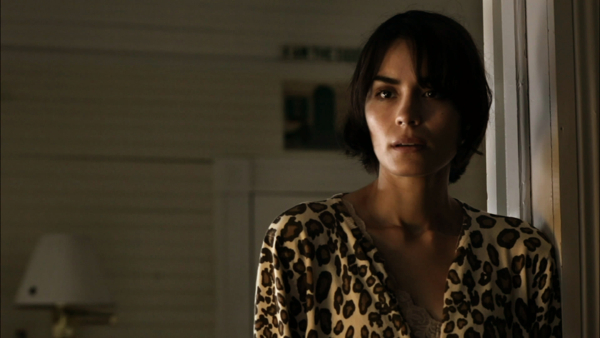Movie review by Greg Carlson
Cult filmmaker Monte Hellman, now approaching eighty years of age, returns to features following a two decade absence with “Road to Nowhere,” an atmospheric noir more interested in the line between illusion and reality than any half-baked crime employed to turn the gears of plot. From the opening title sequence, which credits the fictional characters populating the movie, to the deliberately cryptic snippets of information doled out to maintain interest, “Road to Nowhere” won’t generate the rabid following enjoyed by Hellman’s fantastic, career-defining “Two-Lane Blacktop.”
“Road to Nowhere” mostly tracks the progress of Hollywood-based Mitchell Haven (Tygh Runyan), a laid back artist whose iceberg indifference suggests an unlikely degree of dispassionate aloofness for a feature filmmaker, during the production of an account of a North Carolina-set felony that involves enough murder, financial malfeasance, identity switching, record doctoring, and double-crossing to make even Phyllis Dietrichson’s head spin. Haven’s own faculties are seriously impaired by his infatuation with initially reluctant ingénue Laurel Graham (Shannyn Sossamon), the actress who may or may not be the very person whose misdeeds inspired the fictionalized script adaptation.
This farfetched concept sounds like a device straight from David Lynch’s playbook, but “Road to Nowhere” ultimately lacks the ambition, imagination, and audacity of films like “Lost Highway,” “Mulholland Drive,” and “Inland Empire.” Hellman’s interest in the gimmick also waxes and wanes throughout the unhurried collection of chronologically jumbled scenes that connect some of the dots, and the presence of a snoopy insurance investigator (Waylon Payne) and a local blogger (Dominique Swain) fails to add much spark or urgency to the resolution of the mystery.
Many viewers are likely to become impatient with Hellman’s creeping pace, and the director’s trick of pulling back to reveal a camera crew shooting a scene that we have been led to believe has unfolded outside the devilishly opaque drama is used so often that a “boy who cried wolf” weariness settles over the whole enterprise. Independent and student moviemakers will relate to several of Hellman’s on-set asides about the challenges of a life spent shooting pictures, and the director’s supply of battle scars lends zesty verisimilitude to the depiction of cinema as a dream factory.
The movie’s unfortunately apt title teases at Hellman’s endgame, a heady brew of cinephilia that trots out a steady parade of inside jokes and references to movie stars then (Louise Brooks) and now (Scarlett Johansson). Hellman’s friend and collaborator Steven Gaydos, who provided the screenplay, is the executive editor for “Variety,” and industry fixture Peter Bart appears as himself in a cameo weirdly evocative of “Entourage.” The low-key Mitch Haven, as he makes the movie within the movie, unwinds with “The Lady Eve,” “The Spirit of the Beehive,” and “The Seventh Seal,” schooling his femme fatale muse with bromides on the indescribable genius of shining lights like Preston Sturges, Victor Erice, and Ingmar Bergman. When Haven croaks that Bergman’s masterpiece has “never looked better” following some iconic clips of Antonius Block challenging Death to a game of chess, you can’t be sure if the joke is on the fatuous character or the trusting viewer.
